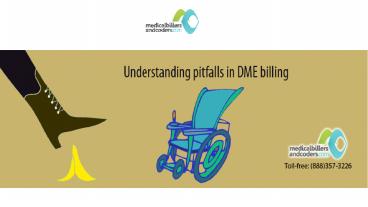Understanding pitfalls in DME billing - PowerPoint PPT Presentation
Title:
Understanding pitfalls in DME billing
Description:
Millions of dollars can be lost if pitfalls are not understood and are repeated time and again in the billing and coding of medical practices, especially for ‘Durable Medical Equipment (DME).’ – PowerPoint PPT presentation
Number of Views:21
Title: Understanding pitfalls in DME billing
1
(No Transcript)
2
Understanding pitfalls in DME billing
Billing is a vital aspect of any business, and
healthcare is no exception. Millions of dollars
can be lost if pitfalls are not understood and
are repeated time and again in the billing and
coding of medical practices, especially for
Durable Medical Equipment (DME). This equipment
typically serves a medical purpose and is used
routinely. It can be bought or rented as per the
requirement and is used at the residence of the
beneficiary. As DME supplies must be certified
and documented, billing of such items usually
undergoes some difficulties. Improper payments
occur if the DME has not been prescribed/documente
d by a physician, policy violations, or if the
funds are paid to the incorrect entity or have
been used for some other purpose rather than
those prescribed. Policy violations occur if
the DME is billed to the wrong insurer, or
improper documentation is submitted without the
signatures of the physician or the beneficiary,
or receipts are missing. Pitfalls under
insufficient documentation in DME billing include
submitting a claim with insufficient/incorrect
codes or mismatched dates on the documentation
and the corresponding claim. Also, the physician
prescribing the DME must be identified and
enrolled in the Provider Enrollment, Chain, and
Ownership System (PECOS) and must be of a
specialty type that is permissible/authorized to
order or refer the service/item being billed.
3
Understanding pitfalls in DME billing
Reimbursements are lost if codes on the claim and
documentation are different or the invoices are
missing and if the documentation and the bills do
not support the physician orders or delivery
tickets. Sometimes, errors occur in the number of
DME billed and the actual DME received by the
beneficiary or if the number of units was not
calculated properly. To avoid such errors,
quality control activities must be conducted.
Checks must be done on the documentation with
respect to the DME provided, supplied, and
claimed. The insurer of the beneficiary must be
determined before claiming as a primary payer.
Quality control must be checked for the number of
units billed, procedure or service code, match of
service dates on the documentation, product
description, and the number of DME units which
should be the same on the claim and the
documentation. Moreover, for terminally ill
patients, suppliers cannot bill for DME. The
hospice provider must pay for the same and, while
billing Medicare for such services, the hospice
must use the GW modifier. Another aspect to be
kept in mind is the billing of the maximum of 62
units of service per month of the medication
budesonide by DME suppliers. As per
www.aapc.com, DME suppliers must comprise a
discharge date on incoming claims.
4
Understanding pitfalls in DME billing
This should be billed for HCPCS Level II
E0935 Continuous passive motion CPM device. The
POS, in this case, is most often 12 (home). To
ensure a proper crossover for a CPM device, DME
suppliers should include discharge date reporting
within the 2400 NTE (notes segment), not in 2300
DTP03 on incoming version 5010A1 837 professional
claims, when billing their DME MAC
electronically. For timely and accurate
reimbursements it is imperative to be well aware
of the rules and common errors in DME billing.































